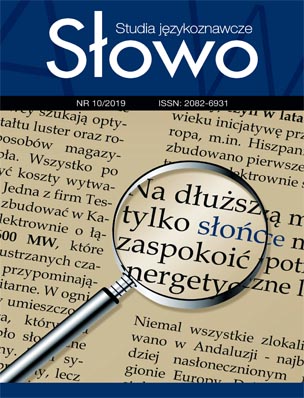Składniowa „mówioność” w powieści Doroty Masłowskiej „Kochanie, zabiłam nasze koty”
DOI:
https://doi.org/10.15584/slowo.2019.10.11Słowa kluczowe:
user colloquial style, imitation of spoken language, syntactic tendencies in literatureAbstrakt
Syntactic treatments, which imitate spoken language, are crucial determinants of the colloquial style, alongside lexis. Responsible for the impression of interacting or communing with the spontaneously created text, which is a record of the living language of the narrator and characters, they are concerned with numerous simplifications and schemes. Among many diversified linguistic phenomena found in the novel by D. Masłowska, entitled “Kochanie, zabiłam nasze koty” (English title: “Honey, I killed our cats”, seemingly contradictory syntactic tendencies are used; the elliptical nature of syntax on the one hand, and, on the other hand, numerous repetitions both with regards to lexis and the construction of sentences. The segmentation or breaking up of utterances, as well as their excessive expansions, is similarly contradictory. Drawing from the spoken language aims to connect the at times unreal word depicted in the novel with the reality of the recipient, and to present the literary characters in a reliable way, more often than not associated with ordinariness.Downloads
Bibliografia
Adamiszyn Z., 1995, Styl potoczny [w:] Przewodnik po stylistyce polskiej, red. S. Gajda, Opole, s. 183–197.
Ampel T., 1978, Elipsa i powtórzenie w żywej mowie [w:] Studia nad składnią polszczyzny mówionej, red. S. Grabias i in., Wrocław, s. 177–182.
Anusiewicz J., 1992, Potoczność jako sposób doświadczania świata i jako postawa wobec świata [w:] Potoczność w języku i kulturze red. J. Anusiewicz i F. Nieckula, Wrocław, s. 9–20.
Bartmiński J., 1978, Swoiste formy orzeczeń w języku ustnym [w:] Studia nad składnią polszczyzny mówionej, red. S. Grabias i in., Wrocław, s. 159–175.
Bartmiński J., 1992, Język potoczny [w:] Potoczność w języku i kulturze, red. J. Anusiewicz i F. Nieckula, Wrocław, 37–54.
Bartmiński J., 2001, Styl potoczny [w:] Współczesny język polski, red. J. Bartmiński, Lublin, s. 115–134.
Data K., 2015, Oralność tekstów Jana Kochanowskiego, „Quaestiones Oralitatis”, nr I/2, s. 85–99.
Furdal A., 1973, Klasyfikacja odmian współczesnego języka polskiego, Wrocław.
Jodłowski S., 2002, Zasady interpunkcji, Kraków.
Kita M., 1991, Ekspansja potoczności [w:] Studia polonistyczne, red. A. Kowalska, A. Wilkoń, Katowice, s. 83–90.
Klemensiewicz Z., 1953, O różnych odmianach współczesnej polszczyzny, Warszawa.
Lubaś W., 2000, Rola słownictwa potocznego w polszczyźnie ostatniego dziesięciolecia [w:] Słownictwo współczesnej polszczyzny w dobie przemian, red. J. Mazur, Lublin, s. 59–68.
Masłowska D., 2012, Kochanie, zabiłam nasze koty, Warszawa.
Nowakowska A., 1978, Stylizacja na język mówiony w polskiej powieści współczesnej [w:] Studia nad składnią polszczyzny mówionej, red. S. Grabias i in., Wrocław, s. 251–259.
Niemczyk-Jacek M., 2015, Kategoria potoczności w tekście literackim na przykładzie dramatów Stanisława Wyspiańskiego, Kraków.
Ożóg K., 1990, Leksykon metatekstowy współczesnej polszczyzny mówionej. Wybrane zagadnienia, Kraków.
Ożóg K., 2001, Ekspansywna potoczność [w:] Polszczyzna przełomu XX i XXI wieku, Rzeszów, s. 48–72.
Pospiszylowa A., 1973, Wyodrębnienie dowolnej części zdania w oddzielne wypowiedzenie, „Język Polski” LIII, s. 330–337.
Saloni Z., 1977, W sprawie interpunkcyjnego usamodzielnienia członu zdaniowego, „Język Polski” LVII, s. 261–272.
Skudrzykowa A., 1993, O pewnym sposobie tworzenia iluzji mówioności w literaturze (na przykładzie współczesnej prozy polskiej) [w:] Z problemów współczesnego języka polskiego, red. J. Warchala, A. Wilkoń, Katowice, s. 42–55.
Stasienko A., 2011, Zjawisko parcelacji w polskiej literaturze językoznawczej, „Zeszyty Naukowe Uniwersytetu Rzeszowskiego. Seria Filologiczna. Glottodydaktyka” z. 3, s. 147–154.
Suska D., 1996, Leksykalne wyznaczniki stylizacji potocznej w Bazie Sokołowskiej Marka Hłaski, „Prace Naukowe Wyższej Szkoły Pedagogicznej w Częstochowie” z. 3, s. 215–233.
Warchala J., 2003, Kategoria potoczności w języku, Katowice.
Wilkoń A., 2000, Typologia odmian współczesnej polszczyzny, Katowice.
Pobrania
Opublikowane
Jak cytować
Numer
Dział
Licencja
Prawa autorskie (c) 2019 Słowo. Studia językoznawcze

Utwór dostępny jest na licencji Creative Commons Uznanie autorstwa – Użycie niekomercyjne 4.0 Międzynarodowe.


